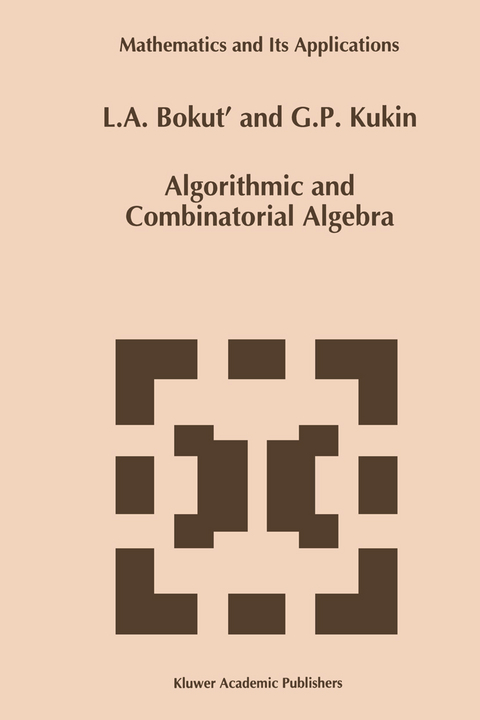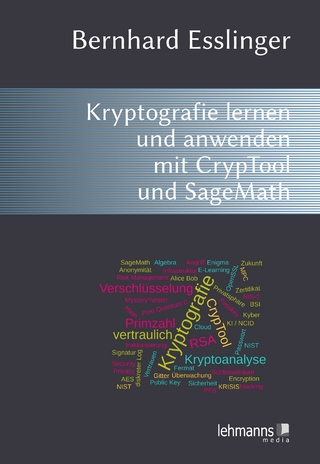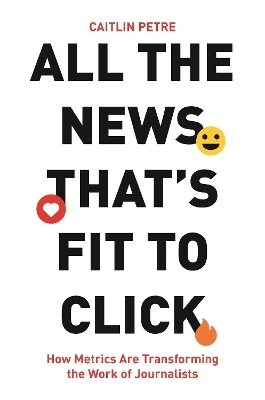
Algorithmic and Combinatorial Algebra
Springer (Verlag)
978-0-7923-2313-6 (ISBN)
Even three decades ago, the words 'combinatorial algebra' contrasting, for in stance, the words 'combinatorial topology,' were not a common designation for some branch of mathematics. The collocation 'combinatorial group theory' seems to ap pear first as the title of the book by A. Karras, W. Magnus, and D. Solitar [182] and, later on, it served as the title of the book by R. C. Lyndon and P. Schupp [247]. Nowadays, specialists do not question the existence of 'combinatorial algebra' as a special algebraic activity. The activity is distinguished not only by its objects of research (that are effectively given to some extent) but also by its methods (ef fective to some extent). To be more exact, we could approximately define the term 'combinatorial algebra' for the purposes of this book, as follows: So we call a part of algebra dealing with groups, semi groups , associative algebras, Lie algebras, and other algebraic systems which are given by generators and defining relations {in the first and particular place, free groups, semigroups, algebras, etc. )j a part in which we study universal constructions, viz. free products, lINN-extensions, etc. j and, finally, a part where specific methods such as the Composition Method (in other words, the Diamond Lemma, see [49]) are applied. Surely, the above explanation is far from covering the full scope of the term (compare the prefaces to the books mentioned above).
1 Composition Method for Associative Algebras.- 1.1 Introduction.- 1.2 Free Semigroups and Free Groups.- 1.3 The Composition Lemma.- 1.4 The Composition Lemma for Semigroup Algebras.- 1.5 The Generalised Clifford Algebra and Some Other Examples.- 1.6 Finite-Dimensional Representation of a Generalised Clifford Algebra.- 1.7 More on Embeddings into Simple Algebras.- 2 Free Lie Algebras.- 2.1 Introduction.- 2.2 The Definition of Free Lie Algebras.- 2.3 Projective Algebras.- 2.4 Elementary Transformations and Automorphisms of Free Algebras.- 2.5 Lie Algebra Derivations.- 2.6 The Ideal of Codimension 1.- 2.7 Constructing Generators for an Arbitrary Subalgebra in a Free Lie Algebra.- 2.8 The Shirshov Theorem on Free Lie Algebra Subalgebras.- 2.9 Automorphisms of Free Lie Algebras of Finite Rank.- 2.10 A Criterion for a Lie Algebra to be Free.- 2.11 Bases of a Free Lie Algebra.- 2.12 Construction of Free Lie Algebras.- 2.13 Universal Enveloping Associative Algebra.- 2.14 On Subrings of Free Rings with Operators.- 2.15 Embedding Lie Rings into Associative Rings with Operators.- 2.16 Restricted Lie Algebras.- 2.17 Relatively Free Lie Algebras.- 2.18 Embedding Countable-Dimensional Lie Algebras into Lie Algebras with Two Generators.- 2.19 The Residual Finiteness of Associative and Lie Algebras.- 2.20 Residual Finiteness of Free Rings and Algebras.- 3 The Composition Method in the Theory of Lie Algebras.- 3.1 Introduction.- 3.2 The Composition Lemma.- 3.3 Formulation of Decision Problems. One-Relator Lie Algebras.- 3.4 Embedding Lie Algebras into Simple Lie Algebras.- 3.5 The Main Algorithmic Problems for Lie Algebras are Unsolvable.- 3.6 Unrecognizable Markov Properties for Finitely Presented Lie Algebras.- 3.7 Defining Relations of a Subalgebra.- 3.8 Residual Finiteness and Decision Problems.- 3.9 On Residual Finiteness of One-Relator Lie Algebras.- 3.10 Constructing Free Resolutions.- 3.11 Cohomological Dimension of Almost Free Lie Algebras.- 4 Amalgamated Products of Lie Algebras.- 4.1 Introduction.- 4.2 Definition of Amalgamated Products.- 4.3 Constructing the Free Product of Associative Algebras without 1.- 4.4 Constructing the Amalgamated Product of Lie Algebras.- 4.5 Subalgebras of the Free Product of Lie Algebras.- 4.6 Generators of a Subalgebra of the Free Product of Lie Algebras.- 4.7 Decomposition of a Free Product into the Sum of Two Subalgebras, One Free.- 4.8 Decomposition of a Subalgebra of a Free Product into the Sum of Two Subalgebras, One Free.- 4.9 The Theorem on Subalgebras of an Amalgamated Product of Lie Algebras.- 4.10 Free Subalgebras in a Free Product of Lie Algebras.- 4.11 The Case in Which the Kurosh Formula Almost Holds.- 4.12 Supplementary Facts on Free Products.- 4.13 Residual Finiteness of Free Products of Associative and Lie Algebras.- 4.14 Residual Finiteness of Free Soluble Lie Algebras with respect to Inclusion into Finitely Generated Subalgebras.- 4.15 On Residual Finiteness of Free Soluble Groups with respect to Inclusion into Finitely Generated Subgroups.- 4.16 On Residual Properties of Free Products of Lie Algebras. Central Systems in Free Products.- 5 The Problem of Endomorph Reducibility and Relatively Free Groups with the Word Problem Unsolvable.- 5.1 Introduction.- 5.2 When the Problem of Endomorph Reducibility for Relatively Free Rings is Unsolvable.- 5.3 When the Problem of Endomorph Reducibility is Solvable.- 5.4 The Problem of Endomorph Reducibility for Relatively Free Groups.- 5.5 The Variety R Included in NN.- 5.6 The Free Group T of the Variety
$$ (/mathcal{A}_2^2 /cap /mathcal{N}_2 )/mathcal{A}_2 /mathcal{R} $$ and its Quotient Group S.- 5.7 The Main Construction.- 5.8 Application to Constructing Non-Finitely-Based Varieties.- 5.9 An Interpretation of Polynomials.- 5.10 Unsolvability of Some Algorithmic Problems in the Theory of Group.- 6 The Constructive Method in the Theory of HNN-extensions. Groups with Standard Normal Form.- 6.1 Introduction.- 6.2 Novikov-Boone Groups.- 6.3 The Novikov Lemma and the Britton Lemma.- 6.4 The Definition of Groups with Standard Normal Form.- 6.5 The Novikov Group AP1P2.- 6.6 The Boone Group.- 7 The Constructive Method for HNN-extensions and the Conjugacy Problem for Novikov-Boone Groups.- 7.1 Introduction.- 7.2 The Conjugacy Problem for the Group G1.- 7.3 The Group G2.- 7.4 Some Calculuses.- 7.5 The Conjugacy Problem for the Group AP1P2.- 7.6 Auxiliary facts.- Appendix 1 Calculations in Free Groups.- Appendix 2 Algorithmic Properties of the Wreath Products of Groups.- Appendix 3 Survey of the Theory of Absolutely Free Algebras.
| Erscheint lt. Verlag | 31.5.1994 |
|---|---|
| Reihe/Serie | Mathematics and Its Applications ; 255 | Mathematics and Its Applications ; 255 |
| Zusatzinfo | XVI, 384 p. |
| Verlagsort | Dordrecht |
| Sprache | englisch |
| Maße | 155 x 235 mm |
| Themenwelt | Informatik ► Theorie / Studium ► Algorithmen |
| Mathematik / Informatik ► Mathematik ► Algebra | |
| Mathematik / Informatik ► Mathematik ► Analysis | |
| Mathematik / Informatik ► Mathematik ► Arithmetik / Zahlentheorie | |
| ISBN-10 | 0-7923-2313-0 / 0792323130 |
| ISBN-13 | 978-0-7923-2313-6 / 9780792323136 |
| Zustand | Neuware |
| Informationen gemäß Produktsicherheitsverordnung (GPSR) | |
| Haben Sie eine Frage zum Produkt? |
aus dem Bereich


